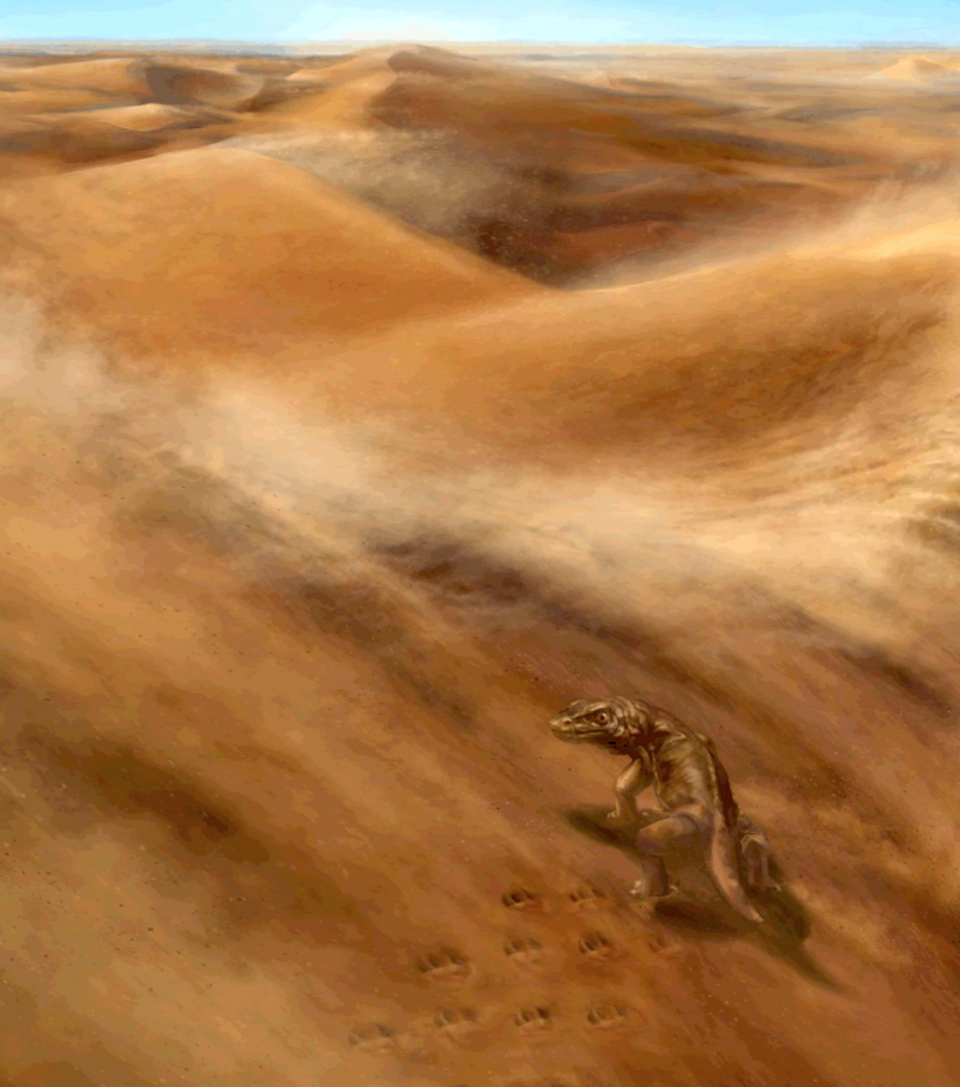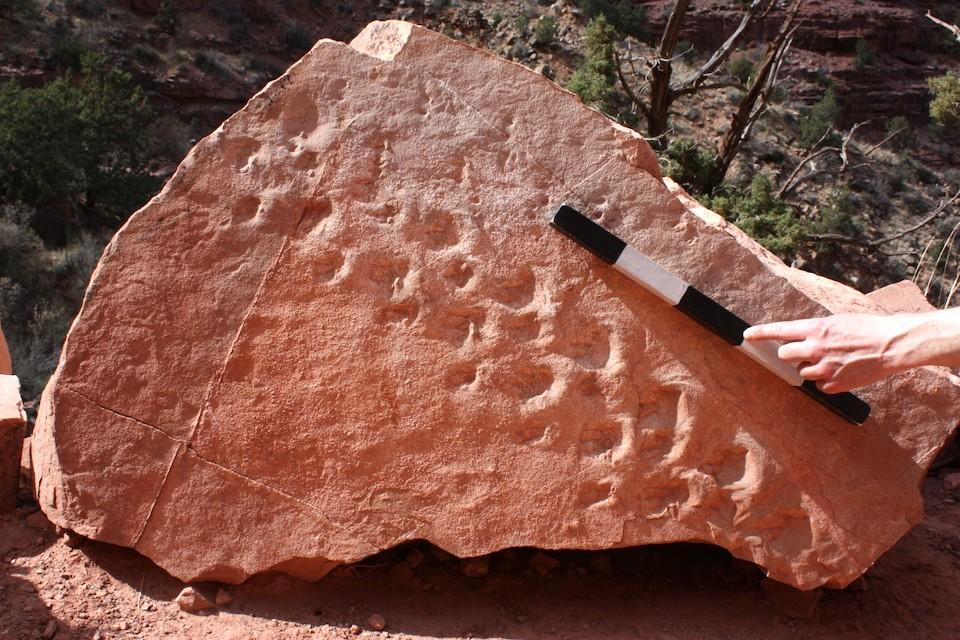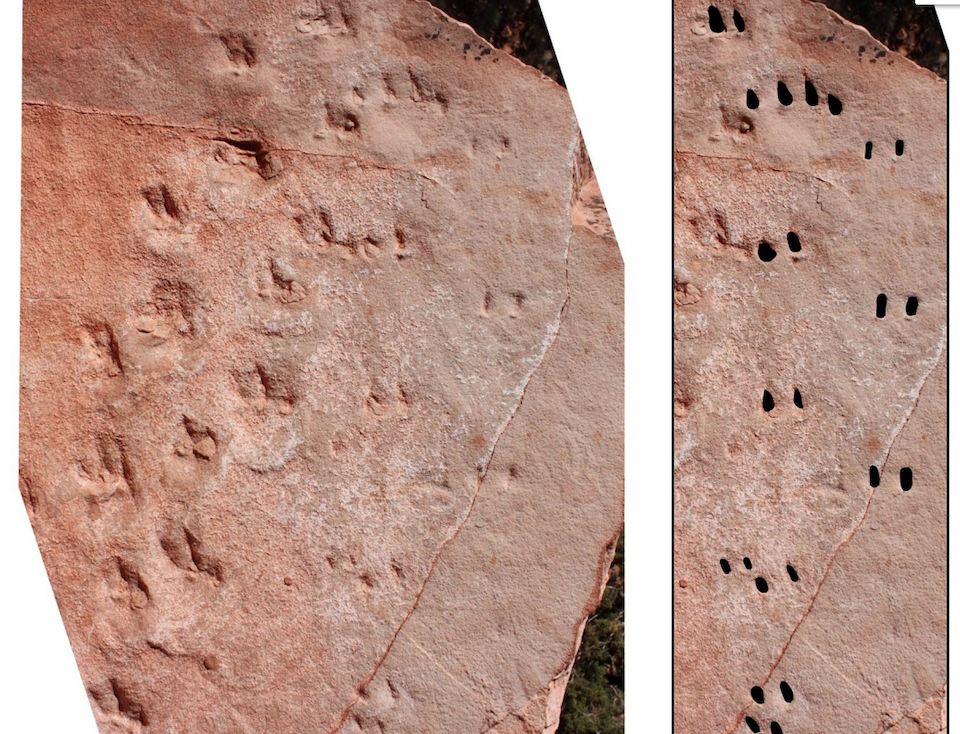
Artist’s rendering of a basal amniote moving diagonally up a sand dune/Art by Emily Waldman
Editor's note: This updates with additional details from Stephen Rowland.
A new chapter to Grand Canyon National Park's geologic past has come to light in the unique form of two sets of fossilized tracks more than 300 million years old that are lying in view of any hiker on the Bright Angel Trail. Those tracks, according to paleontologists, "are by far the oldest vertebrate tracks in Grand Canyon."
“They literally are on the edge of the trail," Stephen Rowland, a University of Nevada Las Vegas palentologist who studied the tracks, said Thursday morning from his office. "I talked to the trail crew chief, and kind of the myth was that they had fallen on the trail and the trail crew had moved them off, but he told me that that rock is sitting right where it fell. They didn’t move it at all.”
It was back when the terrain the Bright Angel Trail traverses was an island surrounded by the Paradox Seaway, an estimated 313 million years ago, that two animals, possibly reptiles, left their tracks on a sand dune. Those tracks came to light after a slab of sandstone had peeled away from a hillside near the trail and was spotted in 2016 by a Norwegian geology professor on a field trip.
The animals that left the tracks were generally identified as "basal amniotes," lizard-like animals that could lay their eggs on land, as opposed to "anamniotes," which laid their's in water.
"The nurseries of amniote evolutionary innovation were Carboniferous tropical forests. The freedom from having to lay their eggs in water permitted basal amniotes to inhabit terrestrial settings that were ecologically inaccessible to amphibians," noted Rowland and two colleagues, Mario V. Caputo and Zachary A. Jensen, in a paper published Wednesday in the journal PLOS One.

Bright Angel Trackway found in a boulder alongside the trail/Stephen Rowland
This is just the latest discovery of fossilized traces of the prehistoric past at the Grand Canyon. It was a little more than a year ago when the discovery of another, slightly younger, trackway was announced. That one dated back 280 million years, just about to the arrival of the Permian Period and before dinosaurs walked the Earth.
Thursday's announcement of the Bright Angel trackway extends by roughly 30 million years the age of fossilized footprints locked in the national park's sandstone.
“These are by far the oldest vertebrate tracks in Grand Canyon, which is known for its abundant fossil tracks," said Rowland. "More significantly, they are among the oldest tracks on Earth of shelled-egg-laying animals, such as reptiles, and the earliest evidence of vertebrate animals walking in sand dunes."
The paleontologist said it was not only unique to have two sets of tracks side-by-side in the Manakacha Formation, but to have any was highly unusual.
"To have two of them on the same rock surface I think is really quite extraordinary," he said during a phone call. "In younger rocks, up in the Permian and the Coconino Sandstone for example, there are plenty of surfaces that have multiple tracks on them. In general, it’s not all that unusual to get more than one trackway on the same surface, but in the Manakacha Formation, which has previously revealed no tracks at all, to have two of them on the same surface is quite extraordinary.”
The tracks were spotted four years ago by Allan Krill, a Norwegian geology professor on a field trip to Grand Canyon with his students. Krill then reached out to Rowland for help in identifying them.

Side-by-side view of trackways found along the Bright Angel Trail. The right-side image has the second set of smaller tracks blackened for emphasis/Stephen Rowland
Rowland, Caputo, and Jensen determined that there were two different trackways made by the animals as they headed uphill across a sand dune.
"That second trackway, the one that’s just the claw marks, really was something that I didn’t pay close attention to when I was there because the main trackway is just so conspicuous, that’s what really grabs your attention," said Rowland. "It wasn’t until I was looking at my photos back on campus that I said, 'Wait a minute, there’s something else going on here.' And then of course I’ve been back out to the site a couple more times looking really carefully at that. That was really a surprise to see a second trackway that is superimposed on the first one."
In studying the tracks, the three determined that the animals had a lateral-sequence gait, in which the legs on one side of the creatures move in succession, with the rear leg striding forward followed by the foreleg, alternating with the movement of the two legs on the opposite side.
“Living species of tetrapods―dogs and cats, for example―routinely use a lateral-sequence gait when they walk slowly,” said Rowland. “The Bright Angel Trail tracks document the use of this gait very early in the history of vertebrate animals. We previously had no information about that.”
Perhaps even more unusual than it was to find tracks in that particular geologic formation was to find a second slab of sandstone bearing casts of the prints.

Rocks with impressions and casts of the tracks/Stephen Rowland
"There’s really two pieces, two surfaces, two separate rocks that have tracks on them, and they’re matching, what we call 'part' and 'counterpart,'" Rowland explained. "So when the rock fell off the cliff, apparently it cracked open right along that bedding plane, and so the rock that’s right next to the trail has imprints of the animals, and the one that’s down the slope a little ways is the top side, which has natural casts. That is, the ‘positive’ casts of that trackway.
"I’m hopeful -- and I’ve made it clear to the Park Service -- that fragement is also important and it would make a wonderful display, kind of an open book display showing both surfaces. I think that would be a real eyecatcher,” he said.
For now, Rowland is trying to convince the Park Service it's important to remove the boulders bearing the impressions.
“They have not been removed. I’m talking with the Park Service right now, and my impression was they were waiting to see a formal scientific paper published before they were convinced that it was important enough to move them," said the paleontologist. "So we’re in discussions with the Park Service right now. I’m hopeful that they’ll be moved pretty quickly, because now with this paper getting published there will be more interest in it and more opportunities for vandalism or people doing stupid things that are going to damage the tracks."
Traveler reached out Thursday morning to Grand Canyon staff to ask about whether the slabs will be removed and was awaiting a response.



Comments
As much as I would like to see these tracks in situ, I agree with the professor that they must be removed and displayed in a protected setting. A minority of people (but unfortunately large enough) will try to either make off with this, or inadvertantly, or otherwise, destroy these fossil tracks. They should be protected.